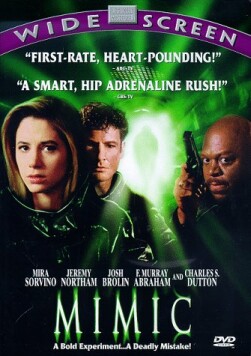Mimic
Mimic, written by Matthew Robbins and Guillermo Del Toro and directed
by Del Toro (Cronos) is almost an old-fashioned creature feature — a
cross between the slime-is-alive flick and the monsters-in-the- subway
flick — but it is a surprisingly watchable and suspenseful example of the
kind. Del Toro, who showed his cleverness and originality in Cronos makes
use of the same qualities here, plus a strong cast, to breathe new life into
what might seem very tired material. Even more impressively, he does so without
the kind of postmodern archness which has come to be a continual irritant if a
very occasional delight in most films of this type.
The medium-high concept is that, two years before the action of the film
begins, a new plague called
Strickler’s Disease, carried by
cockroaches, started killing the children of New York in terrifying numbers. The
film opens with pseudo-documentary footage of the means by which a brilliant
entomologist, Dr. Susan Tyler (Mira Sorvino) genetically engineered a new
species of bug, called “the Judas
breed” to wipe out the cockroaches.
The Judas bugs were also engineered (this is stretching credulity a little) with
a “suicide
gene” so that they would proceed to
wipe themselves out. Dr. Tyler and her colleague from the Center for Disease
Control, Dr. Peter Mann (Jeremy Northam) have been hailed as heroes and public
benefactors.
Now, two years later and Dr. Susan and Dr. Peter have married and are trying
to start a family. At the same time, among derelicts and
“mole
people,” something is causing strange
disappearances and, in a few cases, horrible deaths. It does not take long for
the audience to put together these two strands of narrative and realize that the
Judas bugs did not all self-destruct. That any watcher of horror movies will
have expected. What is unexpected is that they have developed lungs, grown to
human size and evolved to mimic the human form, all in the space of two years
(somehow they must have “sped up its
breeding cycle,” Dr Tyler theorizes).
In short, beneficent science has inadvertently created a
Frankenstein’s monster which is
roaming wild beneath the streets of the city.
Del Toro wisely avoids the temptation to become too portentously
philosophical about this. There is a former professor of Dr
Tyler’s, played by F. Murray Abraham,
who does a bit of cluck-clucking about the consequences of her messing with
nature, but he hasn’t much to do. And
what you might think of as the obligatory scenes in which police and potentates
and politicians get involved and shout at each other and attempt to organize
responses to the threat to the city are completely omitted. The battle against
the bugs is fought entirely by Dr. Peter and Dr. Susan, plus an assistant to the
former (Josh Brolin), a city transport cop called Leonard (Charles S. Dutton)
and a wizened old Italian shoemaker (Giancarlo Giannini) and his weird son, Chuy
(Alexander Goodwin) who seem to have wandered into this film from a fairy
tale..
The good thing about the movie is that we are made to care about the main
characters and therefore what happens to them, and that the suspense as to what
is going to happen to them is kept up almost continually until the end.
It is also a cool and very spooky idea to conceive of the big bugs as having
adapted to their environment by mimicking their main predator, man. The sheer
physical means by which they put on a human appearance and then kill you with
their sword-like appendages is visually very impressive. The bad thing is the
strain on our credulity of the accelerated evolution and the fact that, when two
of the most sympathetic characters are carried off by the bugs, they are not
killed, whereas everybody else to suffer this misfortune dies instantly and
horribly. Lucky thing it was these two, huh? But on the whole, the skillful and
original handling of the material makes this that rare thing, a contemporary
horror movie that is worth seeing.
Discover more from James Bowman
Subscribe to get the latest posts to your email.








